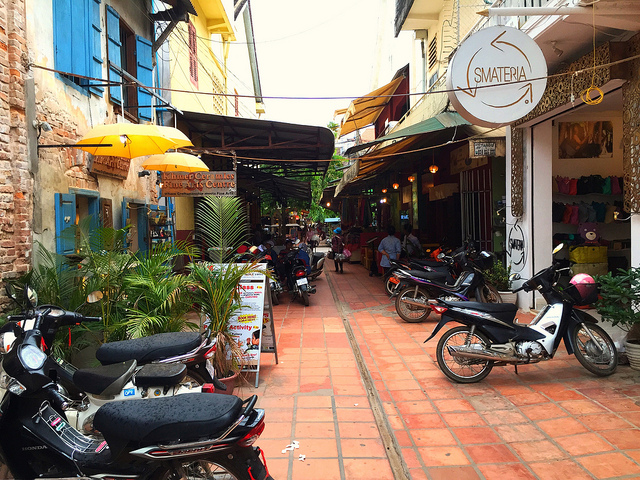|
Six hours northwest of Phnom Penh and 30 minutes from Tonle Sap Lake, lies Siem Reap. A tourist mecca where 2 million visitors from all over the world flock each year to comb through the ancient Angkor temples during the day and take shots on the famous Pub Street at night. There are just over 900,000 people in Siem Province, of which 45% live in poverty, placing it among the three poorest provinces in Cambodia. But things are slowly changing here. Access to education combined with a surge in tourism over the last 20 years has provided new opportunities within Siem Reap's city limits. Tour operators, hotel managers and service jobs are available for the young, educated population (the average age is 21 - a staggering consequence of the genocide committed by the Khmer Rouge), yet salaries still waver around $70 per month, making it difficult for anyone to build a sustainable future. Visitors enjoy the 'benefit' of a struggling city with a dependence on tourism to fuel its economy. The Old Market/Pub Street area consists of a few square blocks packed with restaurants, bars and hundreds of stands selling everything from crepes to smoothies to elephant pants and “I heart Cambodia” tanks. 20-somethings and mature western travelers stroll through the bustling streets at night, ducking in and out of pubs and noshing on hamburgers, pizza, and burritos. If it doesn't feel like the rest of Cambodia, it's because it isn't. Much of this area was developed for westerners, by westerners. What's driving those 2 million visitors each year? About five miles outside of Old Town is arguably the most impressive ancient temple complex in the world. Siem Reap’s main attraction, the Angkor temples, draw millions each year, sustaining the hundreds of hotels, restaurants and bars that have popped up everywhere in this town. Regardless of the long or short term effect of tourism on this beautiful city, the temples are simply magnificent. The true benefit of tourism in Siem Reap though, is the influx of support from global NGO's. Still rebuilding from its tumultuous past, Siem Reap, much like Phnom Penh, offers a number of restaurants and coffee shop NGOs, each with a percentage of proceeds that support a different local cause. If you’re visiting and want to help, support one of the many existing organizations that are seeking long term solutions rather than giving money (or milk, see below) to people on the streets. A few of our favorites are Common Grounds Coffee, Marum Restaurant, and Sisters Srey. The incredible effect of travel and tourism here is good and bad. The opportunities created by jobs in the hospitality and service industry are at odds with the cultural erosion caused by westernization, as noodle carts are replaced by burger joints. It's in places like Siem Reap where sustainable, responsible travel is most important. Stay, shop, and eat local, support the NGO's, learn about and respect the local culture, and we'll all be better off. the details:
0 Comments
Your comment will be posted after it is approved.
Leave a Reply. |
Cohica TravelA travel design agency. Categories
All
Archives
October 2023
Follow us on Instagram @CohicaTravel
|







 RSS Feed
RSS Feed
